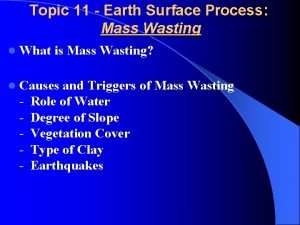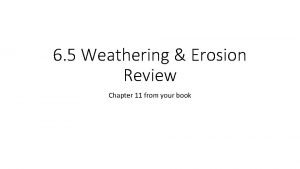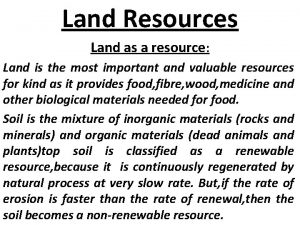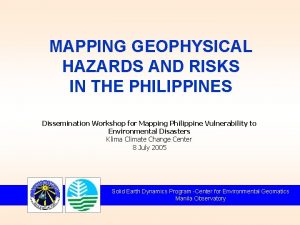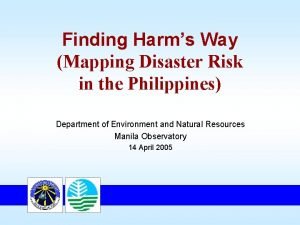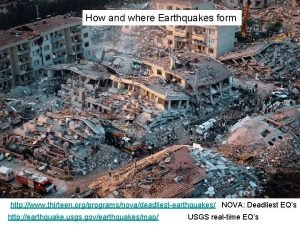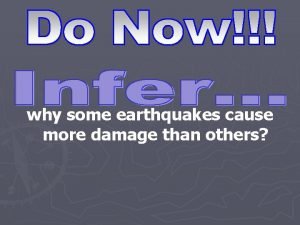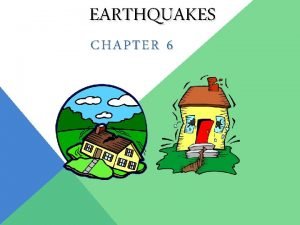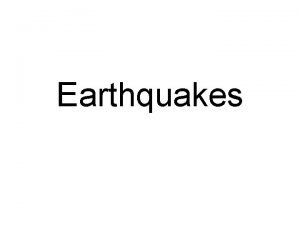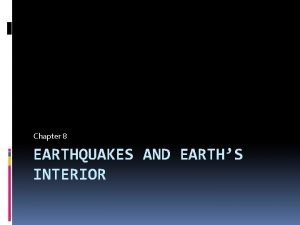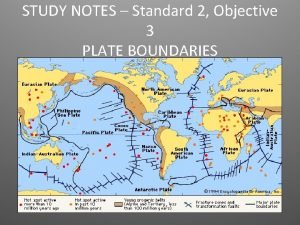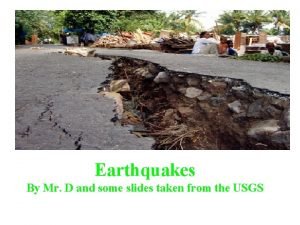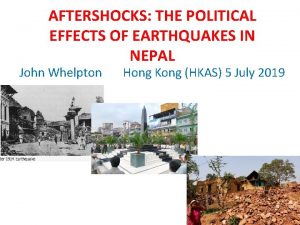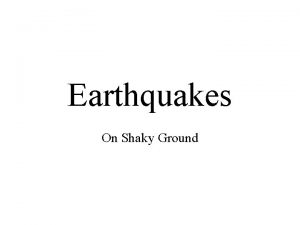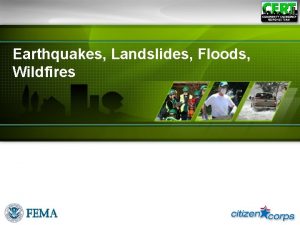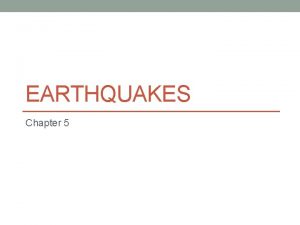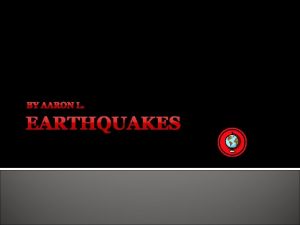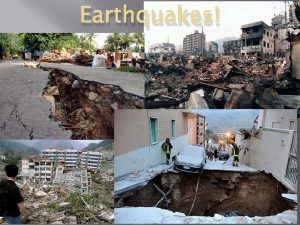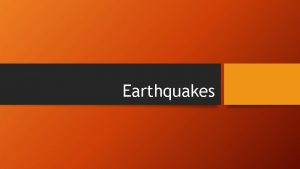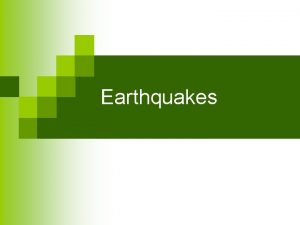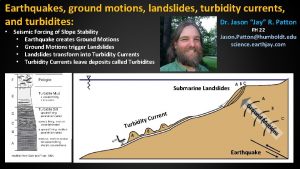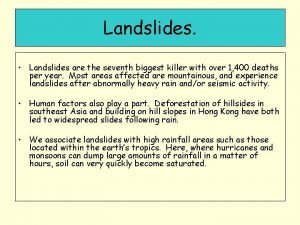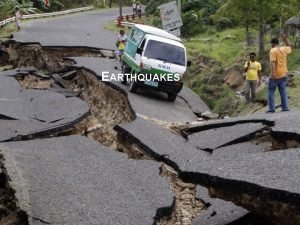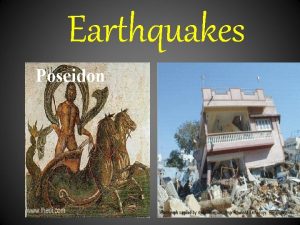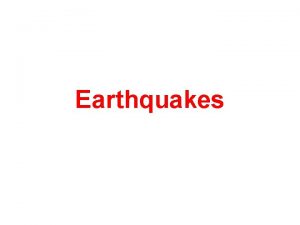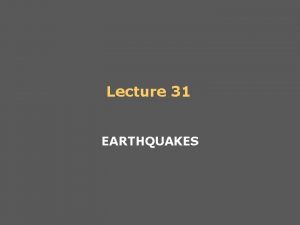HAZARDS Major Hazards of Earthquakes Ground Shaking Landslides




















- Slides: 20

HAZARDS

Major Hazards of Earthquakes • • • Ground Shaking Landslides Fire Building Collapse Tsunamis (Not Tidal Waves!)

Earthquake Hazards 1. Ground shaking • The result of the waves set in motion by the earthquake • Some vibrations move up and down while others move side to side • Most buildings can withstand large up-and-down vibrations, but not side-to-side (cause collapse)

2. Liquifaction • Vibrations cause groundwater to rise, turning solid ground into a liquid-like material. • Buildings built on solid rock experience little damage; buildings located on bog muds or soft fill suffer severe damage

3. Tsunamis • Large ocean waves produced when earthquakes occur under water. • Caused by a large displacement in the water column

Tsunami’s • A tsunami is a large sea wave generated by an underwater earthquake, volcano, or landslide. When the 2004 Sumatra earthquake ruptured the sea floor, creating a tsunami

Building for Earthquakes

Safest & Most Dangerous Buildings • • • Small, Wood-frame House - Safest Steel-Frame Reinforced Concrete Unreinforced Masonry Adobe - Most Dangerous



How Do Earthquakes Affect Buildings? • Have you ever seen pictures of a city after a strong earthquake has hit? • You may have noticed that some buildings don’t have very much damage. Other buildings, however, are totally destroyed. • Engineers can study the damage to learn how to make buildings that are stronger and safer.

Dampers

Cross Braces • df

Flexible Pipes • sd

Active Tendon System • dsf

Base Isolators • sdf

• sdf

What to do in case of an Earthquake • If you are inside when an earthquake happens, crouch or lie facedown under a table or a desk. Make sure you are far away from windows or heavy objects that might fall. Cover your head with your hands. If you are outside during an earthquake, lie face down on the ground. Make sure you are far from buildings, power lines, and trees. Cover your head with your hands. If you are in a car or bus, you should ask the driver to stop. Everyone should stay inside the car or bus until the earthquake is over

Earthquake Safety What to do in case of an earthquake

After an Earthquake • Being in an earthquake can be scary. After an earthquake happens, people are often confused about what happened. They may not know what to do or where to go. • Try to stay calm. • Look around you. • If you are near something dangerous, like a power line or broken glass, get away as quickly as you can. • Never go into a building after an earthquake until your parent, a teacher, a police officer, or a firefighter tells you it is safe. • Always remember that there could be aftershocks. Aftershocks are weaker earthquakes that can happen after a large earthquake. Even though they are weaker than the main earthquake, aftershocks can still be very strong and damaging. • Stick to your earthquake plan. • Stay together with your family or friends so that they know you are safe. • Have a Plan and a KIT!
 Mass wasting processes
Mass wasting processes Seizure
Seizure Characteristics of the percussion family
Characteristics of the percussion family We will not be moved when everything around is shaking
We will not be moved when everything around is shaking Landslides mudflows slump and creep are all examples of
Landslides mudflows slump and creep are all examples of Man induced landslides
Man induced landslides Basilan at romblon tsunami
Basilan at romblon tsunami Angular sedimentary rocks
Angular sedimentary rocks Earthquake-induced shallow landslides in the philippines
Earthquake-induced shallow landslides in the philippines Why do earthquakes occur
Why do earthquakes occur Why some earthquakes cause more damage than others
Why some earthquakes cause more damage than others Whats the main cause of earthquakes
Whats the main cause of earthquakes Seismograph
Seismograph Chapter 8 earthquakes and earth's interior answer key
Chapter 8 earthquakes and earth's interior answer key Explain natural disasters
Explain natural disasters A large crack in the earth formed by a river or earthquakes
A large crack in the earth formed by a river or earthquakes What are the factors of earthquake
What are the factors of earthquake Frequent earthquakes in an area may indicate
Frequent earthquakes in an area may indicate In what section of earth do earthquakes happen
In what section of earth do earthquakes happen Types of earthquake
Types of earthquake Earthquakes
Earthquakes
